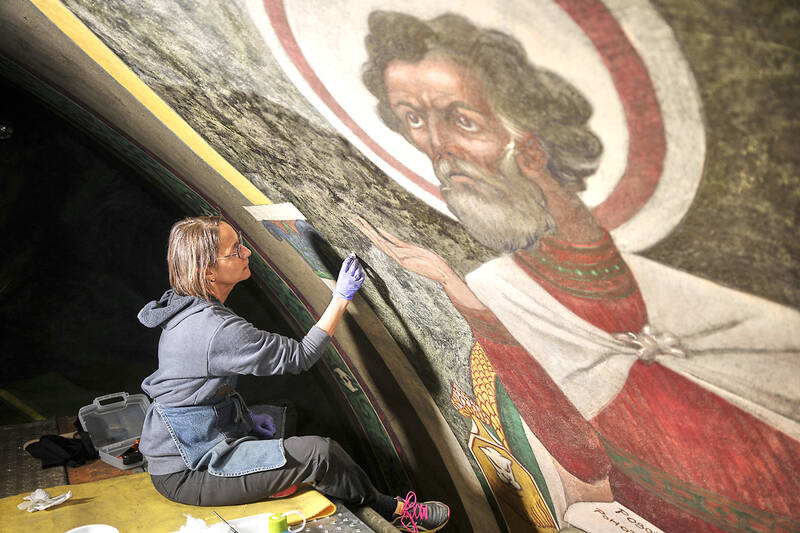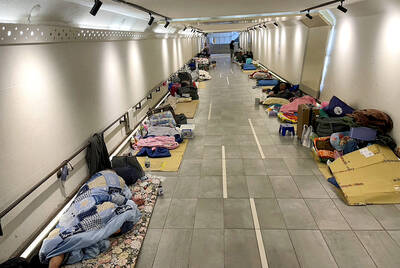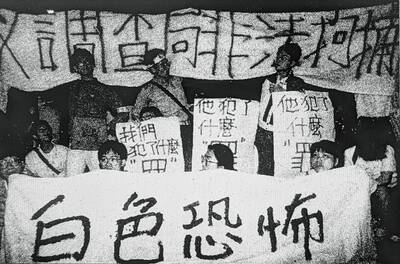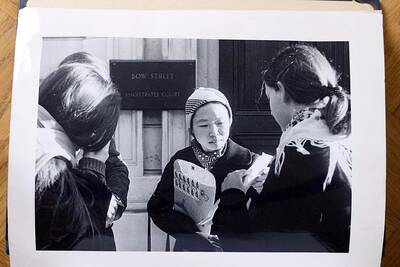When the scaffolding came down inside the unassuming hilltop church near Pittsburgh, it revealed a raging storm of biblical proportions.
A wide-eyed Moses holds the Ten Commandments aloft in righteous fury, ready to shatter the tablets when his followers abandon God for a golden calf. Lightning sizzles and a tornado surges in the background.
The late artist Maxo Vanka created the mural in 1941, based on a scene from the Book of Exodus. It’s one of 25 murals that cover the walls and ceilings of St. Nicholas Croatian Catholic Church.

Photo: AP
Vanka, a Croatian American immigrant like most of the original parishioners, painted the scenes in bursts of creative energy that led to marathon-long sessions where he captured stark social inequities alongside traditional religious themes.
The murals depict scenes with dualities. An angelic justice figure contrasts with a haunting figure of injustice in a World War I gas mask. Mothers — posed like the grief-stricken Madonnas of traditional pietas — weep over their sons who died in war or were worked to death by American industry. A callous tycoon ignores a beggar. A Madonna snaps a rifle on a battlefield.
At the same time, the murals honor the achievements of the immigrant parishioners and the consolations of faith, home and maternal care.
The work has drawn international visitors and become a beloved local landmark. One former priest for the church called it “The Sistine Chapel of Pittsburgh”— a sanctuary dominated by the single artist’s tour-de-force.
But decades of smoke, atmospheric salts and water leaks had dulled and damaged the paintings.
Since 2009, the Society to Preserve the Millvale Murals of Maxo Vanka has been leading a painstaking conservation effort — one section at a time.
Results of the latest work completed in late May are evident.
The paint in Moses’ florid cheeks and deeply grooved facial lines now stand out starkly. Behind him, the large hand of God now gleams brighter. So too do the hair and flamelike feathers of onlooking angels, painted in Vanka’s unique palette of bright pink and sea-foam green.
“It’s like seeing it how he really wanted it for the first time,” Vanka’s granddaughter, Marya Halderman, said of the conservation work earlier this year. “He always called it his gift to America.”
Over four months, a team of more than a dozen workers climbed a 9.8-meter scaffold to clean off grime, extract corrosive salts from the walls, stabilize plaster and delicately fill in areas of lost paint with new pastels and watercolors, which can easily be reversed by current or future conservators.
They worked to reveal the artist’s original work, including the vigorous brushstrokes he applied amid long hours that stretched into the night, when Vanka reported eating little food, consuming much coffee and often seeing a ghost.
The murals “speak to a unique time in history, World War II and immigration and social justice,” says the Reverend Nicholas Vaskov, director of the Shrines of Pittsburgh, a cluster of historic Catholic parishes that includes St. Nicholas. “To allow them to continue to speak to people and to see that they are preserved is a great gift.”
In January, the crew worked a section that includes the tempestuous Moses and two Gospel scribes in placid poses, St. Matthew and St. Mark.
“One of my favorite things about being a conservator is that I get to touch things that no one has been able to touch for over, what, 70 years?” says Naomi Ruiz, a wall paintings expert. “You really get to see the artist’s brushstrokes, his original hand, his struggle when he’s trying to reach off of his scaffold to reach that last little part. It makes you even want to work harder and longer.”
Challenges loomed. They were working on the side of the church that takes the most sunlight, which has caused more damage, from fluctuations in temperature and humidity.
CROSSING SOCIAL CLASSES
Maksimilijan Vanka was born in 1889 in what is now independent Croatia.
An out-of-wedlock son of nobility, Vanka was raised by a peasant woman, Dora Jugova. She became the prototype for Vanka’s recurring artistic motif of strong, maternal and pious women — such as the sturdy Madonna he depicted with work-worn hands in one of the church’s most prominent murals.
Vanka’s noble family eventually provided him an education. His familiarity with both privilege and poverty gave him insight and sensitivity to people across social classes.
Vanka studied in Belgium and served with the Red Cross during World War I. He immigrated to the US in the 1930s after marrying an American, Margaret Stetten.
A Pittsburgh exhibit of Vanka’s art caught the attention of the late Reverend Albert Zagar, pastor of St. Nicholas. The church had been rebuilt after a fire, its walls now blank and waiting for the right artist.
“They’d found their person,” said Anna Doering, executive director of the Society to Preserve the Millvale Murals of Maxo Vanka.
Vanka transformed the sanctuary in two intense seasons of creativity, in 1937 and 1941.
He fused traditional Catholic iconography with searing commentary on war, capitalism, and immigrant labor and contrasting depictions of communal piety and economic greed.
“It’s religion, expressed in our social life,” Zagar said in 1941. “At the same time, it’s completely Catholic.”
Vanka continued his artistic career until his tragic death in 1963, when he drowned off the coast of Mexico while on vacation.
PRESERVING LOCAL CULTURE
In the decades since, parishioners have cherished the murals, caring for them as best they knew how.
More formal conservation efforts began in 1991, when the artist’s admirers formed the Society to Preserve the Millvale Murals of Maxo Vanka. By 2009, the society was ready to launch professional work in earnest — preserving one mural at a time.
Doering recalls when she first set foot in the church as a consultant.
“My jaw just dropped,” she said. “I had never seen anything like this. And I wanted to be part of it.”
Locals and foundations alike donated. The society also worked with the parish to repair the roof and upgrade climate control systems.
In 2022, the society was awarded a US$471,670 grant through the Save America’s Treasures program, administered by the National Park Service, enabling recent work on the upper part of the church.
###PROCESS OF ART AND SCIENCE
The conservation workers began by brushing and vacuuming off loose dirt and soot. They did further cleaning with sponges and cotton swabs by the thousands.
Much of the grime, Ruiz said, likely resulted from years of atmospheric pollution, ranging from Pittsburgh’s former steel mills to everyday highway traffic.
The crew also worked to reverse damage to the plaster caused by atmospheric salts.
For Ruiz, the murals have universal themes.
“This story that Vanka was telling was specifically for the Croatian people, but it could also speak towards many immigrant families here in the US and how they felt and how they brought a lot of their culture with them,” she said.
UNUSUAL FIELD TRIP
Along with conservation work, the society does educational outreach, bringing in student field trips in tandem with the LIGHT Education Initiative, a Pittsburgh-area program with a mission to equip “the next generation of humanitarians.”
Becky Gaugler, director of education and interpretation for the preservation society, welcomed visiting sixth graders from a nearby school earlier this spring. She told them the murals show “how we can talk about our own stories in relation to those stories in the past.”
One student group gathered beneath two contrasting dinner scenes. In one, a modest family prays over a simple meal of bread and soup. In another, a top-hatted millionaire dines alone, indifferent to the beggar at his feet as an angel weeps.
The students debated which table they’d rather join. The rich man has better food, they noted, but the family appears more hospitable.
“They are very grateful obviously for what they have,” observed sixth-grader Corinne Coppler.
THE BIG PICTURE
Vaskov said the murals remain central to the parish’s identity. Though most services are now in English, the parish still holds a monthly Croatian-language Mass and celebrates other ethnic traditions.
The scaffolding supporting the conservation work posed “a temporary inconvenience to reveal something marvelous,” Vaskov said.
It finally came down in late May, in time for the parish’s 125th anniversary Mass on June 1. Most of the murals have now undergone conservation. More work lies ahead, but it made an opportunity to savor the latest results.
“When you’re up there, you really get caught up in every little spot,” Ruiz said. “Then I look at the big picture. It’s so much better than how it was four months ago. It looks so solid. All the colors just pop.”

From the last quarter of 2001, research shows that real housing prices nearly tripled (before a 2012 law to enforce housing price registration, researchers tracked a few large real estate firms to estimate housing price behavior). Incomes have not kept pace, though this has not yet led to defaults. Instead, an increasing chunk of household income goes to mortgage payments. This suggests that even if incomes grow, the mortgage squeeze will still make voters feel like their paychecks won’t stretch to cover expenses. The housing price rises in the last two decades are now driving higher rents. The rental market

July 21 to July 27 If the “Taiwan Independence Association” (TIA) incident had happened four years earlier, it probably wouldn’t have caused much of an uproar. But the arrest of four young suspected independence activists in the early hours of May 9, 1991, sparked outrage, with many denouncing it as a return to the White Terror — a time when anyone could be detained for suspected seditious activity. Not only had martial law been lifted in 1987, just days earlier on May 1, the government had abolished the Temporary Provisions Effective During the Period of National Mobilization for Suppression of the Communist

Hualien lawmaker Fu Kun-chi (傅?萁) is the prime target of the recall campaigns. They want to bring him and everything he represents crashing down. This is an existential test for Fu and a critical symbolic test for the campaigners. It is also a crucial test for both the Chinese Nationalist Party (KMT) and a personal one for party Chairman Eric Chu (朱立倫). Why is Fu such a lightning rod? LOCAL LORD At the dawn of the 2020s, Fu, running as an independent candidate, beat incumbent Democratic Progressive Party (DPP) lawmaker Hsiao Bi-khim (蕭美琴) and a KMT candidate to return to the legislature representing

Fifty-five years ago, a .25-caliber Beretta fired in the revolving door of New York’s Plaza Hotel set Taiwan on an unexpected path to democracy. As Chinese military incursions intensify today, a new documentary, When the Spring Rain Falls (春雨424), revisits that 1970 assassination attempt on then-vice premier Chiang Ching-kuo (蔣經國). Director Sylvia Feng (馮賢賢) raises the question Taiwan faces under existential threat: “How do we safeguard our fragile democracy and precious freedom?” ASSASSINATION After its retreat to Taiwan in 1949, the Chinese Nationalist Party (KMT) regime under Chiang Kai-shek (蔣介石) imposed a ruthless military rule, crushing democratic aspirations and kidnapping dissidents from